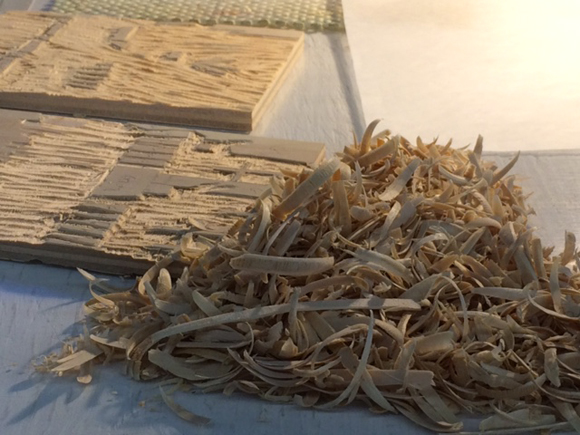 |
| Carving underway on halftone Buddha image. |
Sometime this fall I got captured by the idea of creating a semi-photographic woodblock image as a halftone (continuous tone image made of dots), and since I've been wanting to work with religious images lately I decided to try making halftones of photographs of icons and statues from various religious traditions. In October I started carving circles for the first of these images, a Buddha.
The photo above shows a 13 x 13 inch block of wood with a computer-generated image of a Buddha statue transferred onto it and carving underway. I wanted to work with the optical illusion that a dot pattern invites, where you only see the dots when you're up close, but the image reveals itself at a certain distance, so I chose the coarsest dot pattern I could use and still make out the image. This required the image transfer onto the block to be very precise, so rather than pasting down a laser printout as I often do I wanted to do a true toner transfer. I tried oil of wintergreen and also citrisolve, but I wasn't happy with either so I ended up using Chartpak blender markers which contain a toxic chemical called xylene. I did it outdoors so I wouldn't keel over from the fumes, but I wouldn't recommend xylene as a go-to transfer agent because of the toxicity.
Nevertheless, I got a great transfer and have been plodding along with the carving for about two months.
 | |
| A close view of some circles of varying sizes. |
I thought a drill would be ideal for this. I have a sweet little hand drill with 8 different bit sizes that my dad passed down to me, but after a few tests I realized that there were infinite small variations in the sizes of these dots, from less than 1/32 inch to around 3/8. I could never get exactly the right size bit for each hole. So I've been carving with knives: my two hangi-to and a #2 X-Axto blade.
 |
| Two different sized hangi-to and an X-Acto knife, with tiny circular wood chips. |
When I posted about this on Facebook I got some great tips. Turns out there's a Japanese tool called a tama-to, available at McClain's, that's designed for cutting circles. One of these is on the way to me now, so I'll report back after I've tried it. Another printmaker friend told me about a drill bit that's cone-shaped so you can vary the width of the circles by how deeply you drive the bit. I'll probably give that a try at some point too, but as I was carving today with my knife I began to think about this whole imperfect process of re-creating a computer generated image by hand. The image is perfect when printed out on a digital printer. Why not just do a high-end inkjet print? Or why not use a photographic process like silkscreen or photo etching? What is this drive to do it by hand with a knife on a piece of wood?
As I pondered this, I realized that this arduous process — this attempt to make 6,000 perfect circles with my imperfect tools and my shaky hand and my farsighted middle-aged eyes —is precisely what religion at its best calls forth in a human being. It's this human striving for something perfect, beautiful and pure in the midst of the imperfection and hardship of life that I could feel being recapitulated in a small way for me in this process.
So maybe I'll stick with the knife.
Happy 2016, dear blog readers.
 |
| I use a portable easel with a couple of different bench hooks to keep the block upright and close to my eyes. |













































